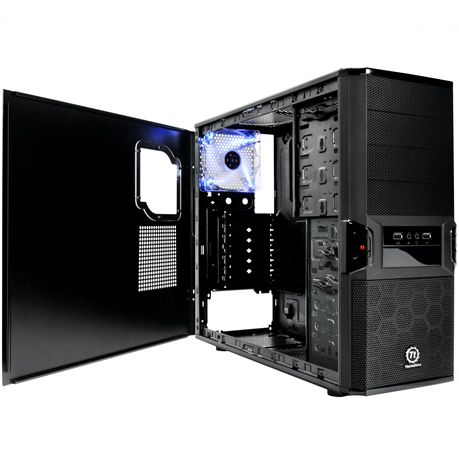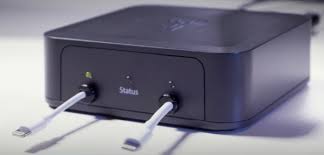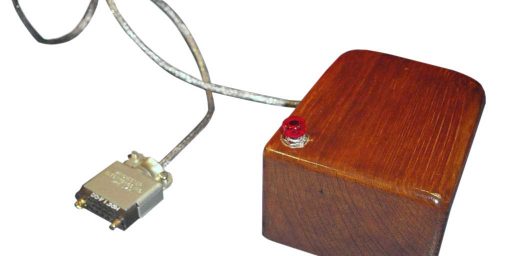Building a Better Budget PC
Can OTB build a better $500 computer than PC World? Let's find out...

I was thumbing through the most recent issue of PC World and noticed that they had an article about the benefits of building your own PC. I approve of this — I built my own PC and building a desktop will, if you’re savvy, save you hundreds of dollars against pre-assembled systems (and there’s just no contest vs laptops). But while I approved of their encouragement towards a DIY system, I was a little less enthused at one of their example builds, which was a Budget PC designed to be built for less than $500. Don’t get me wrong–PC World build wasn’t bad, but it didn’t really outperform a computer you can get pre-assembled for $500 (which the magazine admits), and it also doesn’t leave a lot of potential for future upgrades.
The latter is important is because part of your philosophy towards building a budget PC shouldn’t just be looking at prices–you need to build on a solid foundation that allows for upgrades without replacing several parts at once. This is one place I think that PC World failed. The other is simply not shopping around enough. By just scanning their parts list, I was pretty sure I could build a more powerful computer that provided a better foundation for upgrades, and still turn it in for under $500. And after some online window shopping, I turned out to be right.
The PC World Build
For Comparison’s sake, here’s the parts list for the PC World build:
CPU – AMD Athlon II x3 445 (3.1 GHz) – $90
Motherboard – Biostar TA890GXB – $95
RAM – Crucial DDR3 – 1333MHz 2 1GB modules – $57
Case – Rosewill R102-P-BK – $30
Power Supply – Cooler Master Elite 460W – $30
Hard Drive – Seagate Barracuda 7200.12 500GB – $49
OS – Windows 7 Home Premium 64bit (OEM) – $99
Keyboard – Microsoft Comfort Curve Keyboard 2000 – $15
Mouse – Microsoft Comfort Optical Mouse 1000 – $10
Optical Drive – Asus – DVD-E818A6T – $17
TOTAL: $493
The Outside the Beltway Build
The CPU: – Athlon II x 4 640 – $100
Adding $10 to PC World‘s price gets us another core–a no brainer. The frequency is slightly less (3.1 GHz vs. 3.0 GHz), but that’s nothing that a little overclocking can’t cure, but even at stock you should get better performance out of the Athlon IIx4.
Motherboard: – MSI 785G-E53 – $10
This is the only real step down from the PC World build, but it’s pretty tiny, and the other aspects of the board make up for it. The difference between the 785G and 890 chipsets aren’t going to make nearly as much of a difference in performance compared to some other modifications. This board has some other advantages over the one used by PC World–namely, it’s a full ATX. It also has better integrated audio, and features an IDE port–important for a budget build because it means you can supplement this machine with some legacy parts, like an old IDE hard drive to use for extra storage or for a dual-Linux boot. Plus, Micro Center is running a promo with the processor to give us a processor + motherboard for $110. You can’t beat that with a stick.
RAM – OCZ Signature 4GB DDR3 SDRAM DDR3 1600 – $72
Even on a budget PC, there’s no need to settle for less than 4GB of RAM. These two 2-GB DDR3 sticks not only double the RAM of the PC World build with faster modules, but if you guy at Newegg.com before the end of the month, they’ll throw in an 8GB Flash Drive. That ain’t bad.
Case – Thermaltake V3 Black – $26
For four bucks less than the PC World build, we can pick up a case that provides much better support for future builds. The Thermaltake V3 Black is not only a better looking case, but it supports full ATX boards, provides more room for expansion, and provides significantly better cooling. It’s true it won’t support a 10.5″ graphics card, but at that point you’ll probably want to upgrade cases anyway, so this is a much better deal all around.
Power Supply – OCZ ModXStream Pro 600W – $46
Let’s be honest — 600W is more than this system needs right now. But that doesn’t mean it’s more than what it will need in the future. It wouldn’t make sense to force yourself to upgrade power supplies at the same time you upgrade some other components. This 600W unit will keep you going through a few upgrades, and even better, it’s semi-modular, meaning you only need to add cables as you need them–which keeps the inside of your case neater.
Graphics Card – Asus Radeon 5550 – $55
The Radeon 5550 won’t give you screaming game performance, but it’ll provide decent performance on most modern games, help support video editing, provide good HDMI output and multi-monitor functionality. And a seperate graphics component is invariably going to produce superior results compared to an integrated solution.
Hard Drive – Western Digital Caviar Blue Hard Drive – 500GB, 7200rpm
Same performance for $9 less. A great deal on a hard drive.
Keyboard/Mouse – Inland Pro Wireless Mouse/Keyboard – $22
I’ll be honest — this keyboard isn’t quite as nice as the PC World selection, but by doing the combo, three bucks less gets us two less cords to get tangled up by going wireless. I’m down with that.
Optical Drive – Samsung 22x DVD-RW Burner – $20
Why PC World chose to go with a simple DVD player rather than DVD burner is beyond me, especially when the prices are so good and they had a little wiggle room. Three bucks more here gets us burning capability.
OS – Microsoft Windows 7 Home Premium 64-bit OEM – $100
The Bottom Line
Putting all the pieces together gets us a quad-core system with double the RAM, more power, better graphics and a lot more potential for upgrading than the PC World build — all for $496. Now, I’ll be honest, the Micro Center Processor/Motherboard combo helped a LOT in boosting the power of this system without decimating the wallet, but it still would have been pretty easy to preserve the quad-core processor and still keep the build under $500 even without that deal. All it takes is a little savvy shopping and a clear idea of how you want to build the machine from the ground up.
My only regret here is that I didn’t have the the funds available to build this machine and test the benchmarks against the one’s in the PC World article. But I’m pretty confident that it would have outperformed both their build and the average pre-assembled $500 system. If you feel like putting it together, let me know how it performs.






Can OTB get decent HTML functionality working? Signs point to no…
I built a computer a couple months ago for roughly half the above price, but of course my computer wasn’t nearly as good. On the other hand, I don’t think 95% of people need that extra speed and processing power. If you do, though, power to you. We live in an amazing age.
The computer I built may well be my last. I have long been an advocate of building computers rather than buying stock, but the price difference has collapsed to the point that I am not sure it’s worth it anymore. I don’t know if I’ve just gotten older or richer.
Kudos to you, Alex, for eying the better power supply. When I was looking at PC World’s specs, I was uncomfortable with that 460W. I can’t imagine getting less than 500W these days. Insufficient power supplies cause nothing but headaches. Among other things, it can kill hard drives.
The CPU/MOBO combo sale makes it pretty much impossible to beat your setup..
I’ve read that the OEM install only allows you to actually install win7 once and you’re screwed if you have to re-install. Anyone have experience with the OEM install version of win7?
The quality of the power supply can matter more then it’s actual “rating”. That aside a 460w PSU doesn’t provide much headroom. I’ve been running the same 650watt Antec Earthwatts PSU for the last 3 or so years (non-modular cables SUCKS). The PSU has lasted through two complete system builds and will be used when I do my next system upgrade. Over the long term the more expensive PSU ended up being cheaper for me.
Hmm, what does it make me if the last time I built my own machine it was with a ‘386 processor?
I’d say the tech challenge should be to get OTB working with iPhone again.
(I’ve built computers off and on. It’s a good skill, but it’s a mistake to assume that in all market conditions it beats “specials.” I paid $349 for this quad core (Intel 8200), 4GB, 640GB computer about six months ago. It was a Gateway refurb, at Microcenter, and came with Vista. I wiped that, loaded, Ubuntu and was off … I have to push the DVD button really hard for it to notice but other than that it’s been fine.)
Oh, it’s also important to know, if you are designing a system, what you are optimizing for. That tells you whether you need to focus on CPU, or RAM, or storage.
@Trumwill –
I built a computer a couple months ago for roughly half the above price, but of course my computer wasn’t nearly as good. On the other hand, I don’t think 95% of people need that extra speed and processing power. If you do, though, power to you. We live in an amazing age.
95% of people don’t need it now, but the processing power here should get an average person through at least the next 5 years plus be upgradeable to Windows 8. You could definitely build a speed demon Nettop for half the price, especially if you kick Windows to the curb and run Linux on it.
The computer I built may well be my last. I have long been an advocate of building computers rather than buying stock, but the price difference has collapsed to the point that I am not sure it’s worth it anymore.
I still think it’s worth building. If nothing else, than for superior upgrading capability and better quality interior parts. At worst you usually break even. On my last build, I saved about $250 on a similarly specced refurb system, though granted I used some legacy parts from my old machine to defray costs–but then, that’s another advantage to building.
Kudos to you, Alex, for eying the better power supply. When I was looking at PC World’s specs, I was uncomfortable with that 460W. I can’t imagine getting less than 500W these days.
PSU’s are probably the thing people skimp on the most–to their detriment. When I build a machine, I try to have a power supply that’s doubleof what I need under full load so I have room to expand and to minimize heat and wear on the parts.
@matt –
Yeah, that’s correct about the OEM license–just applies to one machine. As for PSU’s, the OCZ supply is awesome. I run the 700W from the same line and it’s quiet as a mouse and I haven’t had any problems with it.
@john –
You can get great deals on refurbs, but I’ve had some bad luck with them. Plus, again, with a pre-assembled machine you tend to lose some flexibility. However, if you’re talking cost savings, I’ll agree that on a PC build it can sometimes be tough to see them in the budget range unless you’re careful. Get much above a $750 budget, though, and I guarantee that a build is going to out-perform a pre-assembled.
Well Alex, we could start by saying if a $350 machine fails, how much do you need to recover from it? I asked about modes of failure before I bought the thing. What I got back was that it was either software related (vista, junked) or that compact machines fail in power supply. If I know how to build machines I can fix that too, right? Just make a bigger box and stick in the same components.
I have two problems with your $750 dividing line. First it implies a dollar-first decision, which is wrong, especially in this market. We should never say “I want a $500 [or $750]” computer. We should say “I need a computer to do this ___” or “I need a computer to do this ___ faster.”
I was looking for a computer to run Eclipse and the Android emulator faster than my old single core P4 2.4GHz (which gave me really long service). As it happens the emulator is still slow … though it occurs to me now that I should swap out GCJ for the Sun JRE.
So, $750 to do what? You can get a pretty good lookin’ Dell for that:
Dell Studio XPS 7100 AMD 6-Core Hexacore 2.6GHz Desktop (4GB/1TB/Radeon HD5450) $699.99 , Sep. 17 11 AM
http://www.techbargains.com/news_displayItem.cfm/223920
BTW, my plan was to make the $350 quad core SSD based at some point. That should kick things up a bit. Total investment should be below $500.
install Mandriva and save another $100.
Dual-linux boot? so which two versions do you use?
not to sound spammie but ive started buying PCs from linpc.us. pretty good specs, and only about $30 more then a self build (last time I checked). Which is well worth my time saved building and troubleshooting.
@John Persona
FYI – I’m running the Android emulator with the Sun JRE and it’s still slow. It’s just a slow emulator. Real slow.
I’d say the tech challenge should be to get OTB working with iPhone again.
I would settle for the site working correctly on Firefox. Right now I can’t click on half of the links on the right sidebar unless I open the window in IE or some other browser.
Alex,
I do like to be able to pick my own components. That’s for sure. That’s one of the big reasons I am even on the fence as to whether or not to build or buy stock next time around. Otherwise, I’d just buy stock. But then… even this isn’t what it used to be. Even low-end parts are more than adequate most of the time. Technology has so surpassed need in most areas that even a cheap video card does most of what you need. Still, I just feel more comfortable with components from trusted makers, you know? Kingston RAM has never let me down. I know that Seagate will take care of me if a hard drive breaks down. I trust component-makers more than I trust computer makers, in fact, as the latter is more likely to try to pass the buck, and that’s not insignificant. So I can see both sides on a lot of this.
As for PSU’s, I’m an Antec guy. Given some of my bad experiences, it’s one of the things I am willing to spend a lot of money on. Matt is definitely right that quality matters more than the number. I’m not sure how comfortable I would be with anyone’s 460W, though.
An undiscussed thing, one of the things I find interesting is that it used to be that the stock makers used to almost always short RAM. I even had a conspiracy that they did this on purpose to encourage more regular upgrades. Half of the time when computers become “outdated” it’s because of poor maintenance and insufficient RAM (these two go together, as the RAM gets bogged down by a million installed and unused programs and the like.
That’s another advantage to building that we haven’t talked about. You install your OS from scratch and that really, really, really helps if you know what you’re doing. To date, the only stock computers I’ve bought have been laptops and even there I tend to wipe the OS clean and do my own install from scratch. Obviously, you can do that with a stock desktop, too, but it’s easier for me if I just have the component drivers and do it myself. Lenovo is great about making drivers available, but some of the others are less reliable than (trusted) component makers.
I’m pretty bearish in general on upgrades. It’s amazing how little extra oomph the new computers provide anybody. Even not so new computers.
Yeah when my brand new hard drive bricked within a month or so of buying it due to a fatal Firmware flaw they did fix it for free but it took about a week or so because I was able to drop the drive off at their data recovery center in Chicago. On the flip side I’ve NEVER had a WD brick or die on me. Hell I still have an 80 gig drive from early 2000 that’s humming along fine.
I’ve had good luck with both Seagate and Western Digital, but I had a spate of drives that went bad when I learned about the importance of power supplies the hard way. WD had its customer support coming from India (or something of the like), which made things like reading off serial numbers a challenge and they got my name and address very, very wrong (fortunately I caught it in time, though it required another call). Further, WD’s packaging requirements were so stringent that WD themselves did not meet them. That kind of hacked me off. Dealing with Seagate, though, was a heck of a lot better. Customer support was American and packaging requirements were realistic.
Regarding OEM Windows, I believe that they check it against the motherboard, so you can replace anything but the motherboard and it should still work.
“(and there’s just no contest vs laptops).”
Do you have an example build for a lap top?